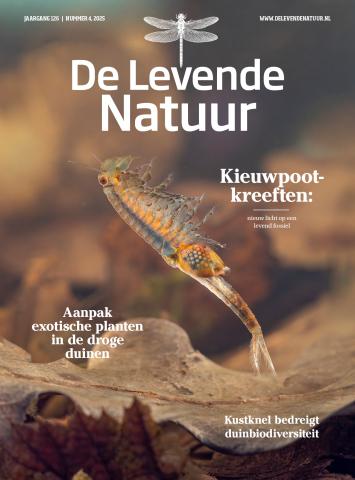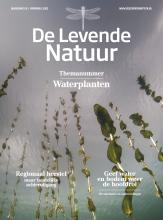De Levende Natuur nummer 4 van 2025 (English summary)
Afbeelding

Cover
Large branchiopods: new light on living fossil
The Netherlands has four native species of large branchiopods (Branchiopoda). These species are rather poorly known to ecologists and conservationists. The present study attempted to map populations so that the relics can be safeguarded. Historical sites were located using old literature and historical topographic maps. At some localities, the branchiopods were found to be still present 30 years after the last sightings. New localities were also identified. At present, three species still occur in the Netherlands: the tadpole shrimp (Lepidurus apus) and two fairy shrimps (Eubranchipus grubii and Chirocephalus diaphanus). With one exception, populations are very small and, therefore, highly vulnerable. This vulnerability certainly applies to the tadpole shrimp populations, which often contained only one or a few specimens per population. It is advised that all species gain legal protection. This gives conservationists better opportunities to implement measures to protect, maintain and expand populations.
Invasive alien species in dunes
In coastal dunes, invasive alien species pose a significant threat to biodiversity. New species enter these ecosystems on a regular basis, while established invaders like Japanese rose (Rosa rugosa) and Oregon grape (Berberis aquifolium) require local control measures. A notable example of ineffective management is golden blue-eyed grass (Sisyrinchium californicum), which after a prolonged lag phase increased exponentially in number without timely intervention. It currently forms a noxious weed that is almost impossible to remove from nature reserves. This case highlights the critical need to remove invasive species early, before they spread widely.
Predicting which species will become invasive is challenging, as invasive traits often only emerge after establishment in a new ecosystem. Therefore, it is advisable to remove all newly introduced species from other continents immediately to prevent future invasions.
Invasive species can affect biodiversity in complex ways. Some may have temporary positive effects in species-poor areas, but they generally decrease species richness in more diverse communities. Effective control of invasive species requires managing populations outside of protected areas as well, as many invasions and recolonizations come from public gardens, parks and roadsides. Invasives can also provide some benefits, such as serving as food sources for certain insects; however, these benefits often do not outweigh their detrimental impacts.
Ultimately, to protect dune biodiversity, early intervention is essential, alongside regulating the import of alien species. Society must critically evaluate the value we place on imported ornamental plants and exotic animals, especially given their potential to cause significant ecological problems. This approach calls for a straightforward and decisive strategy, which will also lead to the removal of non-invasive species. In conclusion, addressing invasive species proactively is vital for preserving biodiversity in coastal dune environments.
Coastal squeeze threatens biodiversity of the dunes
The dune landscape is in trouble worldwide: buildings are advancing on the land side, while the water is rising and the coast is eroding on the seaside. This phenomenon, known as coastal squeeze, limits the space available for dune landscapes, which directly reduces dune plant diversity. In the Netherlands, research shows that a dune width of 3.8 km is needed to approach maximum plant diversity, yet the average width is only 1 km. To protect biodiversity, it is essential that further encroachment of coastal infrastructure is prevented. Additionally, nature management interventions can help to increase dune biodiversity, but most effective is relieving coastal squeeze. In coastal regions where landward expansion is not possible, (mega) nourishments have the potential to create more space for dunes to grow seaward.
The tubeworm crab feels at home in the North Sea
The tubeworm crab (Asthenognathus atlanticus) lives in the tubes of the parchment tubeworm, among others. With the advance of this worm, the number of sightings of these crabs is also increasing. Researchers at Wageningen Marine Research are finding the animal more and more often during their annual survey of coastal waters.
Ditches benefit earthworms, meadow birds and farmers
This study investigated how converting historical ditches (‘greppelland’) into intensively managed grassland affects earthworms and their agro-ecosystem services. The research focused on red and grey earthworm populations in three greppelland plots and three intensive grassland plots in Southwest Friesland during the 2023 meadow bird breeding season. Greppelland, with its microrelief and moisture gradients, retained higher soil moisture during droughts. Initially, no differences in earthworm density were observed, but as soils dried, intensive plots showed significant declines in worm density and reproductive activity, particularly for red earthworms. In greppelland, red earthworms remained active and reproductive, while grey earthworms avoided dormancy, continuing to deliver vital ecosystem services. Preserving or reintroducing greppelland enhances earthworm populations, supporting soil fertility and providing food for meadow birds even in dry periods. This highlights the importance of small ditches for sustainable agricultural landscapes.

